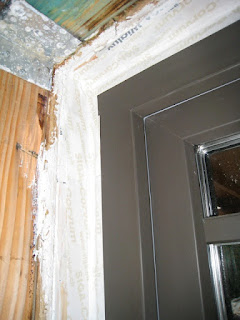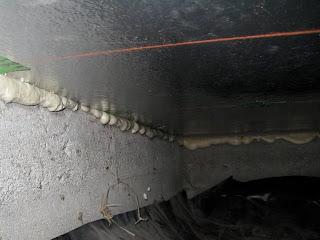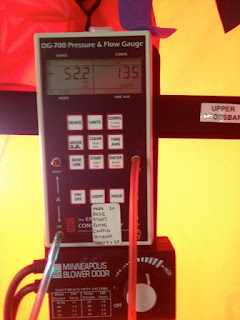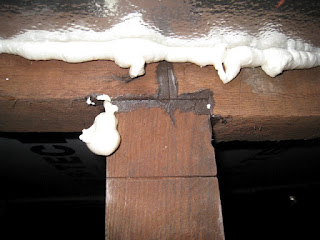First Interim Blower Door Test A Success!
Good news! The first interim blower door test passed the passive house criteria of 0.6 ACH at 50 Pascals!
This was very happy surprise when we stopped by the job site on Wednesday, 8/1/2012, after returning from a long vacation. Riding our bikes into the fenced area we saw that the “blower door” (the red plastic lining fitted into the door frame with a large fan hugged by the elastic band on the plastic sheet) was placed in the front door. Just as we were saying, “Hmm… They’re doing the blower door test today, I don’t think we can get in,” we saw the blower door being dismantled by our air sealing consultant, Terry Nordbye. He was very happy and pleased to tell us that the house passed the blower door test. Yeah!
Then we saw Taylor Darling of Santa Cruz Green Builders, our general contractor, walking out of the house with a big smile on his face and showed us this picture:
This means that the house, at this mid-construction stage, has met one of the most difficult criteria of passive house certification, air tightness test of 0.6 ACH50 maximum. Our approach to air sealing is to do few interim blower door test during construction rather than wait until the very end so that air tightness is ensured along the way. You may ask, what does 0.6 ACH50 maximum mean? Well, ACH stands for Air Change per Hour. The target of 0.6 ACH means 60% of the air volume in the house exchanging with the exterior of the house (leaking) each hour. So, for our house with 1,569 square foot of interior space and 9-feet ceiling, the total volume of air within the house is 14,121 cubic feet. 60% of that is 8,472.6
ft3, which is the maximum allowable air leakage per hour at 50 Pascals (equivalent to having 20 miles per hour wind blowing outside of the house). Now let’s convert the per hour figure to per minute figure to get to a familiar term of CFM (cubic feet per minute) by dividing by 60 (1 hour = 60 minutes). This gives us a target of 141 CFM. As you can see from the above picture (135 CFM at 52.2 Pascals) Taylor and his crew managed to exceed the air tightness criteria! Excellent job, guys!
Taylor said that in the morning the very first blower door test result came in at 0.96ACH and they knew they knew their work for the day would be a quest for air leaks and patching them with foam and tape. Fortunately it turned out to be only few large leaks rather than lots of tiny leaks. One was the drain in the hallway bathtub where it didn’t yet have the p-trap and water in place. Another was a set of penetration made for solar thermal plumbing. The third was a penetration in the top plate that wasn’t visible from the bottom that leaked air into the space between two beams in the ceiling. Here are some photos from Taylor on the examples of air sealing:
 |
| Solar thermal plumbing |
 |
| Sealing around the windows |
 |
| Foam sealing at the perimeter foundation |
 |
| EPS foam board under the floor insulation in the crawlspace |
Taylor and his crew, in addition to being good builders are air sealing rock stars. This cannot be emphasized enough because they’ve managed to make this 90-year old house VERY airtight. I’ve often heard that an average new construction today is about 5~6ACH. What Taylor and his crew managed to do was to get this old house to be 10 times tighter than an average new construction. It’s much harder to get to this level of air tightness with a retrofit because we’ve reused many of the existing structure (foundation, framing, roof, floor) from 90 years ago and therefore less control compared to a new construction. You may also remember that the baseline blower door test for this house was 22 ACH. We kept the vented attic and vented crawlspace so the air sealing was done at the ceiling and the foam board below the floor joist.
Advice and help from our air sealing consultant, Terry Nordbye, was very helpful. At one point during our visit David asked Taylor and Terry about which smoke pens belonged to whom. After they sorted out their tools I asked Taylor, “So how did those smoke pens work in detecting leaks?” His reply was, “We didn’t use the smoke pens. We just listened.” Apparently they boosted up the blower door fan to 180 Pascals and at that pressure they could hear the air leaks quite clearly. One thing that leaked air more than expected was the window hardware. We have lovely triple pane tilt-turn windows from Cascadia and the hardware on the windows leaked air quite a bit.
You may wonder with such air tightness of the house envelope what the indoor air quality will be like. That will be another post on Heat Recovery Ventilator.
About the Author
Chie Kawahara
Chie is one of the co-creator of Midori Haus. When she is not sharing her stories of transforming an old house and giving tours, she enjoys trail running and hiking.



What a nice thinking. I love that. Your information is uncommon and great. This information is great for house Air sealing. So I think that is enough for house air sealing. If you need more information for air sealing.